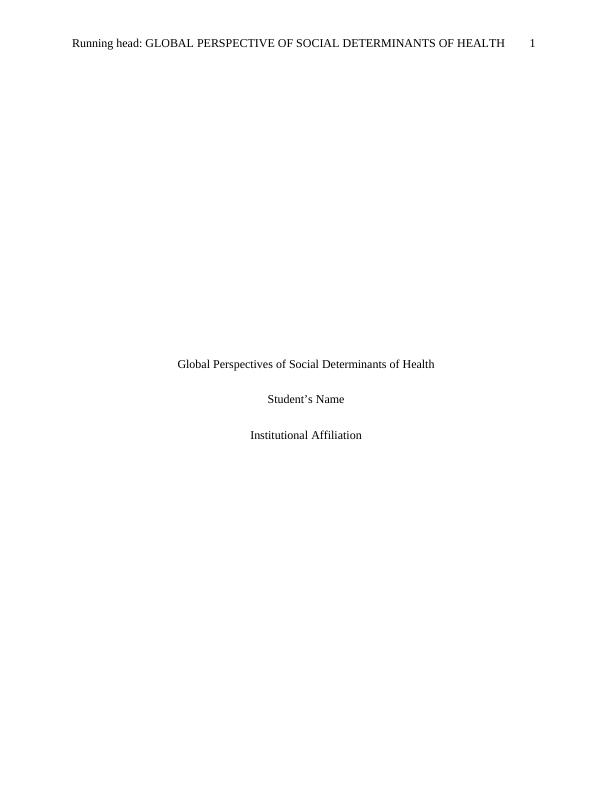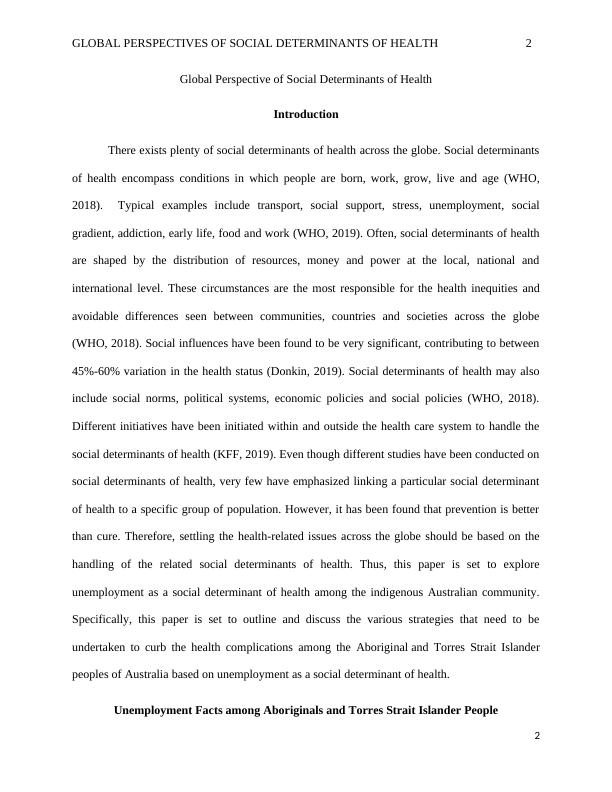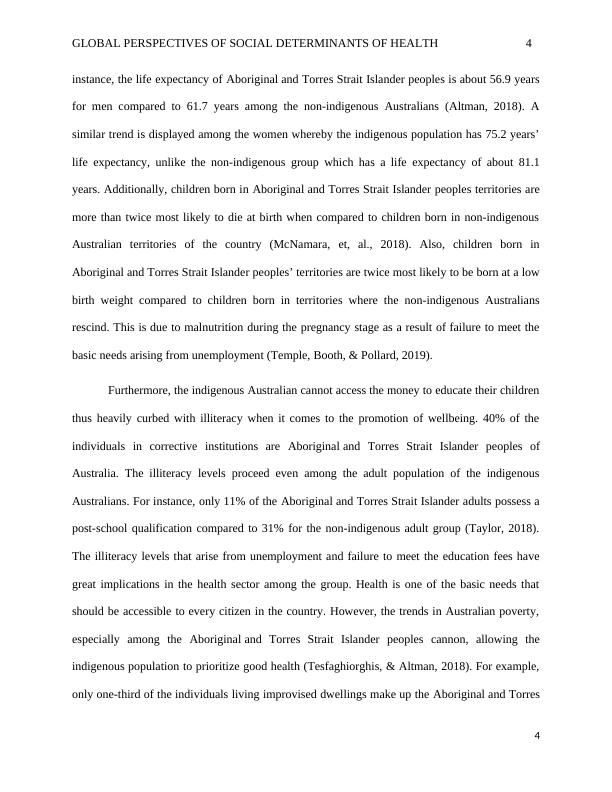Global Perspectives of Social Determinants of Health
Added on 2023-03-17
16 Pages5079 Words88 Views
Running head: GLOBAL PERSPECTIVE OF SOCIAL DETERMINANTS OF HEALTH 1
Global Perspectives of Social Determinants of Health
Student’s Name
Institutional Affiliation
Global Perspectives of Social Determinants of Health
Student’s Name
Institutional Affiliation

GLOBAL PERSPECTIVES OF SOCIAL DETERMINANTS OF HEALTH 2
Global Perspective of Social Determinants of Health
Introduction
There exists plenty of social determinants of health across the globe. Social determinants
of health encompass conditions in which people are born, work, grow, live and age (WHO,
2018). Typical examples include transport, social support, stress, unemployment, social
gradient, addiction, early life, food and work (WHO, 2019). Often, social determinants of health
are shaped by the distribution of resources, money and power at the local, national and
international level. These circumstances are the most responsible for the health inequities and
avoidable differences seen between communities, countries and societies across the globe
(WHO, 2018). Social influences have been found to be very significant, contributing to between
45%-60% variation in the health status (Donkin, 2019). Social determinants of health may also
include social norms, political systems, economic policies and social policies (WHO, 2018).
Different initiatives have been initiated within and outside the health care system to handle the
social determinants of health (KFF, 2019). Even though different studies have been conducted on
social determinants of health, very few have emphasized linking a particular social determinant
of health to a specific group of population. However, it has been found that prevention is better
than cure. Therefore, settling the health-related issues across the globe should be based on the
handling of the related social determinants of health. Thus, this paper is set to explore
unemployment as a social determinant of health among the indigenous Australian community.
Specifically, this paper is set to outline and discuss the various strategies that need to be
undertaken to curb the health complications among the Aboriginal and Torres Strait Islander
peoples of Australia based on unemployment as a social determinant of health.
Unemployment Facts among Aboriginals and Torres Strait Islander People
2
Global Perspective of Social Determinants of Health
Introduction
There exists plenty of social determinants of health across the globe. Social determinants
of health encompass conditions in which people are born, work, grow, live and age (WHO,
2018). Typical examples include transport, social support, stress, unemployment, social
gradient, addiction, early life, food and work (WHO, 2019). Often, social determinants of health
are shaped by the distribution of resources, money and power at the local, national and
international level. These circumstances are the most responsible for the health inequities and
avoidable differences seen between communities, countries and societies across the globe
(WHO, 2018). Social influences have been found to be very significant, contributing to between
45%-60% variation in the health status (Donkin, 2019). Social determinants of health may also
include social norms, political systems, economic policies and social policies (WHO, 2018).
Different initiatives have been initiated within and outside the health care system to handle the
social determinants of health (KFF, 2019). Even though different studies have been conducted on
social determinants of health, very few have emphasized linking a particular social determinant
of health to a specific group of population. However, it has been found that prevention is better
than cure. Therefore, settling the health-related issues across the globe should be based on the
handling of the related social determinants of health. Thus, this paper is set to explore
unemployment as a social determinant of health among the indigenous Australian community.
Specifically, this paper is set to outline and discuss the various strategies that need to be
undertaken to curb the health complications among the Aboriginal and Torres Strait Islander
peoples of Australia based on unemployment as a social determinant of health.
Unemployment Facts among Aboriginals and Torres Strait Islander People
2

GLOBAL PERSPECTIVES OF SOCIAL DETERMINANTS OF HEALTH 3
Generally, Aboriginal and Torres Strait Islander peoples of Australia are the most
disadvantaged groups in Australia when it comes to the aspect of unemployment as a social
determinant of health. Aboriginal and Torres Strait Islander peoples in Australia have the least
employment rate in the country. Currently, the employment rate among Aboriginal and Torres
Strait Islander peoples is about 40% unlike in the entire population in Australia where the
employment rate is at 57% (Smith, 2018). The medium income population in Australia among
the Aboriginal and Torres Strait Islander peoples earns about $231 per week unlike the medium
income earners among the non-indigenous population who earn at least $387 per week. It has
been revealed that only 60% of the Aboriginal and Torres Strait Islander peoples are full-time
workers unlike in the non-indigenous Australians where 72% is on full-time employment (Daly,
2018). The rate of growth of the indigenous population in Australia is higher than the projected
rate of growth in Australian labour market (Daly, 2018). There is a huge rate of unemployment
among the Aboriginal and Torres Strait Islander peoples compared to the non-indigenous
Australian. For instance, research reveals that the employment inequality between the indigenous
and non-indigenous Australians would have been achieved if 77,000 indigenous Australians
would be employed 2006 while keeping the number employed non-indigenous Australians
constant (Duncan, Mavisakalyan, & Tarverdi, 2016). However, one would wonder how these
targets would be achieved if the rate of population among the indigenous Australians is
periodically increasing with a lower rate in the Australian labour market.
Facts Linking Unemployment to Poor Health among Aboriginal and Torres Strait
Islander peoples Australia
The life expectancy among the Aboriginal and Torres Strait Islander peoples of Australia
is much bellow when compared to life expectancy among the non-indigenous Australians. For
3
Generally, Aboriginal and Torres Strait Islander peoples of Australia are the most
disadvantaged groups in Australia when it comes to the aspect of unemployment as a social
determinant of health. Aboriginal and Torres Strait Islander peoples in Australia have the least
employment rate in the country. Currently, the employment rate among Aboriginal and Torres
Strait Islander peoples is about 40% unlike in the entire population in Australia where the
employment rate is at 57% (Smith, 2018). The medium income population in Australia among
the Aboriginal and Torres Strait Islander peoples earns about $231 per week unlike the medium
income earners among the non-indigenous population who earn at least $387 per week. It has
been revealed that only 60% of the Aboriginal and Torres Strait Islander peoples are full-time
workers unlike in the non-indigenous Australians where 72% is on full-time employment (Daly,
2018). The rate of growth of the indigenous population in Australia is higher than the projected
rate of growth in Australian labour market (Daly, 2018). There is a huge rate of unemployment
among the Aboriginal and Torres Strait Islander peoples compared to the non-indigenous
Australian. For instance, research reveals that the employment inequality between the indigenous
and non-indigenous Australians would have been achieved if 77,000 indigenous Australians
would be employed 2006 while keeping the number employed non-indigenous Australians
constant (Duncan, Mavisakalyan, & Tarverdi, 2016). However, one would wonder how these
targets would be achieved if the rate of population among the indigenous Australians is
periodically increasing with a lower rate in the Australian labour market.
Facts Linking Unemployment to Poor Health among Aboriginal and Torres Strait
Islander peoples Australia
The life expectancy among the Aboriginal and Torres Strait Islander peoples of Australia
is much bellow when compared to life expectancy among the non-indigenous Australians. For
3

GLOBAL PERSPECTIVES OF SOCIAL DETERMINANTS OF HEALTH 4
instance, the life expectancy of Aboriginal and Torres Strait Islander peoples is about 56.9 years
for men compared to 61.7 years among the non-indigenous Australians (Altman, 2018). A
similar trend is displayed among the women whereby the indigenous population has 75.2 years’
life expectancy, unlike the non-indigenous group which has a life expectancy of about 81.1
years. Additionally, children born in Aboriginal and Torres Strait Islander peoples territories are
more than twice most likely to die at birth when compared to children born in non-indigenous
Australian territories of the country (McNamara, et, al., 2018). Also, children born in
Aboriginal and Torres Strait Islander peoples’ territories are twice most likely to be born at a low
birth weight compared to children born in territories where the non-indigenous Australians
rescind. This is due to malnutrition during the pregnancy stage as a result of failure to meet the
basic needs arising from unemployment (Temple, Booth, & Pollard, 2019).
Furthermore, the indigenous Australian cannot access the money to educate their children
thus heavily curbed with illiteracy when it comes to the promotion of wellbeing. 40% of the
individuals in corrective institutions are Aboriginal and Torres Strait Islander peoples of
Australia. The illiteracy levels proceed even among the adult population of the indigenous
Australians. For instance, only 11% of the Aboriginal and Torres Strait Islander adults possess a
post-school qualification compared to 31% for the non-indigenous adult group (Taylor, 2018).
The illiteracy levels that arise from unemployment and failure to meet the education fees have
great implications in the health sector among the group. Health is one of the basic needs that
should be accessible to every citizen in the country. However, the trends in Australian poverty,
especially among the Aboriginal and Torres Strait Islander peoples cannon, allowing the
indigenous population to prioritize good health (Tesfaghiorghis, & Altman, 2018). For example,
only one-third of the individuals living improvised dwellings make up the Aboriginal and Torres
4
instance, the life expectancy of Aboriginal and Torres Strait Islander peoples is about 56.9 years
for men compared to 61.7 years among the non-indigenous Australians (Altman, 2018). A
similar trend is displayed among the women whereby the indigenous population has 75.2 years’
life expectancy, unlike the non-indigenous group which has a life expectancy of about 81.1
years. Additionally, children born in Aboriginal and Torres Strait Islander peoples territories are
more than twice most likely to die at birth when compared to children born in non-indigenous
Australian territories of the country (McNamara, et, al., 2018). Also, children born in
Aboriginal and Torres Strait Islander peoples’ territories are twice most likely to be born at a low
birth weight compared to children born in territories where the non-indigenous Australians
rescind. This is due to malnutrition during the pregnancy stage as a result of failure to meet the
basic needs arising from unemployment (Temple, Booth, & Pollard, 2019).
Furthermore, the indigenous Australian cannot access the money to educate their children
thus heavily curbed with illiteracy when it comes to the promotion of wellbeing. 40% of the
individuals in corrective institutions are Aboriginal and Torres Strait Islander peoples of
Australia. The illiteracy levels proceed even among the adult population of the indigenous
Australians. For instance, only 11% of the Aboriginal and Torres Strait Islander adults possess a
post-school qualification compared to 31% for the non-indigenous adult group (Taylor, 2018).
The illiteracy levels that arise from unemployment and failure to meet the education fees have
great implications in the health sector among the group. Health is one of the basic needs that
should be accessible to every citizen in the country. However, the trends in Australian poverty,
especially among the Aboriginal and Torres Strait Islander peoples cannon, allowing the
indigenous population to prioritize good health (Tesfaghiorghis, & Altman, 2018). For example,
only one-third of the individuals living improvised dwellings make up the Aboriginal and Torres
4

End of preview
Want to access all the pages? Upload your documents or become a member.
Related Documents
Public Health Assignment 2022lg...
|9
|1957
|27
Assignment on Aboriginal Knowledge and Experienceslg...
|10
|2651
|12
INDIGENOUS HEALTH ISSUE.lg...
|11
|3087
|1
Health Inequalities Between Aboriginal and Non-Indigenous Populationslg...
|6
|1262
|17
Why Indigenous Peoples Globally Experience Health Disparitieslg...
|6
|1388
|12
Forming a Smoking Cessation Program for Indigenous Blacktown Suburb Residentslg...
|13
|3551
|350
